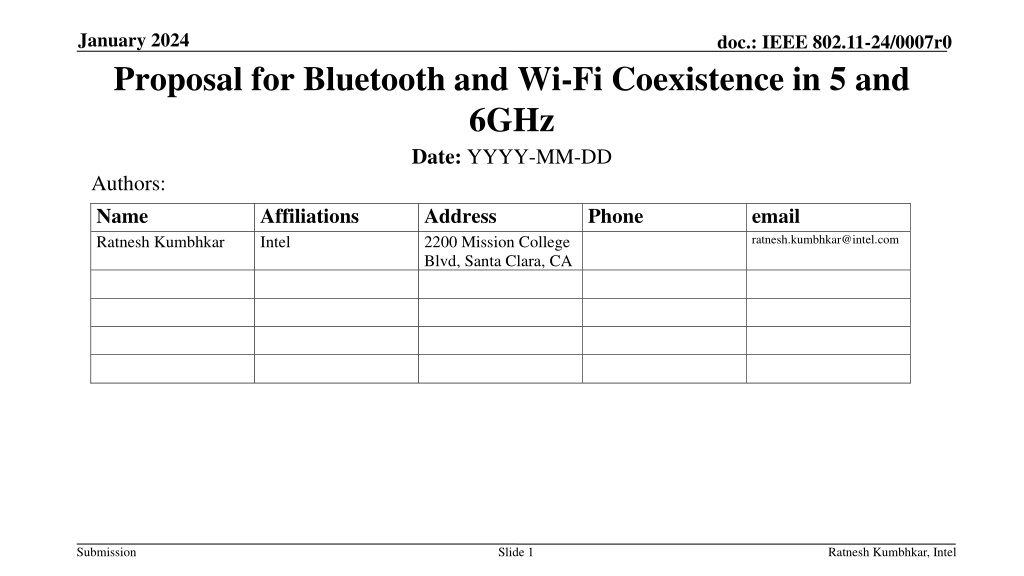

0 likes | 17 Views
This document outlines a proposed framework for coexistence between Wi-Fi and Bluetooth in the 5 and 6 GHz bands. The key principles of the proposal include requirements and protocol improvements in the Bluetooth Higher Bands specification, incorporating concepts like Detect-And-Avoid (DAA) and Listen-Before-Talk (LBT) to address interference issues. The document introduces the concept of Regulated-Detect-and-Avoid (rDAA) and discusses the state machine for higher band operation. Transition scenarios and examples using rDAA are also presented to demonstrate how Bluetooth devices can minimize interference with Wi-Fi in shared spectrum. Overall, the proposal aims to enhance the coexistence capabilities between Bluetooth and Wi-Fi in higher frequency bands.

E N D
January 2024 doc.: IEEE 802.11-24/0007r0 Proposal for Bluetooth and Wi-Fi Coexistence in 5 and 6GHz Date: YYYY-MM-DD Authors: Name Ratnesh Kumbhkar Affiliations Intel Address 2200 Mission College Blvd, Santa Clara, CA Phone email ratnesh.kumbhkar@intel.com Submission Slide 1 Ratnesh Kumbhkar, Intel
January 2024 doc.: IEEE 802.11-24/0007r0 Introduction • This slide outlines a proposed framework for Wi-Fi and Bluetooth coexistence in the 5 and 6 GHz bands, viewed from the perspective of Bluetooth. Submission Slide 2 Ratnesh Kumbhkar, Intel
January 2024 doc.: IEEE 802.11-24/0007r0 Key Principles of the Proposal • Establish a set of requirements and protocol improvements in the Bluetooth Higher Bands (5 and 6 GHz) specification that would facilitate a toolset for coexistence with Wi-Fi. • Detect-And-Avoid (DAA) • Listen-Before-Talk (LBT) • Regulatory determination • Improvements for Wi-Fi/BT collocated devices • Determine the conditions in which a device uses a feature available in the Higher Bands (HB) coexistence toolset, which may rely on factors such as • Regulatory requirements • Spectrum availability • Channel quality • Presence of other devices Submission Slide 3 Ratnesh Kumbhkar, Intel
January 2024 doc.: IEEE 802.11-24/0007r0 Existing Toolset in Bluetooth for Coexistence • Bluetooth specification supports a form of Detect-and-Avoid (DAA) in Adaptive Frequency Hopping (AFH) • The implementers are given the freedom to decide the most suitable way to accomplish this goal. • Can be improved upon, as there is no constraint on the timing requirement • Impact of the narrowband transmission on Wi-Fi signal is shown to be significant without a coexistence mechanism. [2][3] • The effectiveness of AFH (as used in 2.4GHz) can be increased. Submission Slide 4 Ratnesh Kumbhkar, Intel
January 2024 doc.: IEEE 802.11-24/0007r0 State Machine for Higher Band Operation rDAA – regulated-DAA (details on the next slide) LBT – Listen before Talk Note: During transition to the higher band, If LBT is mandated by the regulatory body in the selected sub-band, the default state will be LBT, and the rDAA state will not be considered. Otherwise, the default starting state will be rDAA. Submission Slide 5 Ratnesh Kumbhkar, Intel
January 2024 doc.: IEEE 802.11-24/0007r0 Regulated-Detect-and-Avoid (rDAA) The goal is - • To establish an upper limit on the interference caused by Bluetooth device to Wi-Fi when using DAA. • To expand upon the widely used methodology currently utilized in the ETSI domain and the industry at large for 2.4GHz band (EN 300 328) [1] Proposed rDAARequirement A Bluetooth device shall not do cumulative transmissions above X dBm EIRP (e.g., 0dBm) exceeding Y ms (e.g.,20ms) in a 20MHz Wi-Fi channel once an interference energy of at least Z dBm/MHz (e.g., -70dBm/MHz) starts within the same 20MHz channel. Tk T2 No Bluetooth transmission beyond this. Frequency 20 MHz Wi-Fi starts T3 Tk-1 T1 Time Submission Slide 6 Ratnesh Kumbhkar, Intel
January 2024 doc.: IEEE 802.11-24/0007r0 Higher Band Mode • Transition from rDAA to LBT • If there is significant spectrum overlap and Bluetooth is unable to locate an adequate number of channels to function outside the Wi-Fi occupied spectrum. • Likely useful when Wi-Fi has low to moderate traffic load • Transition from LBT to rDAA • If scans find unused spectrum for Bluetooth to use, it may be advantageous to switch to rDAA. • As highlighted in our previous results, relying on LBT-based access can potentially lead to glitches for Bluetooth. [4] • Note: Compliance with regulations will take precedence over the selection of a channel access method. Submission Slide 7 Ratnesh Kumbhkar, Intel
January 2024 doc.: IEEE 802.11-24/0007r0 Example using rDAA Set of parameters ISO interval Number of subevents Subevent duration Bluetooth channel bandwidth Bluetooth hopping bandwidth 7.5ms 2 1ms 2MHz wide scanning capability Different values of observations per second (sum of active and passive scans) – [200, 500, 1000, 1500, 2000] Bluetooth device limits transmission to ≤20ms in a 20MHz Wi-Fi channel – Expectation is that total Bluetooth transmission time shall not exceed 8×20ms = 160ms in the Wi-Fi occupied 160MHz band. A 20MHz band is vacated if 50% of channels in this band are found to be busy • • 2MHz • 320MHz (160 channels) 160MHz (overlap of 50%), Eight 20MHz channels Wi-Fi bandwidth Assumptions: A Bluetooth device can obtain the channel state information using the following two methods Active scans refer to those conducted during normal transmit and receive operations. Passive scans refers to those carried out during periods of inactivity by specifically turning the scanner ON for scanning purposes • Submission Slide 8 Ratnesh Kumbhkar, Intel
January 2024 doc.: IEEE 802.11-24/0007r0 Collision with Wi-Fi Corresponds to 20ms for this example Submission Slide 9 Ratnesh Kumbhkar, Intel
January 2024 doc.: IEEE 802.11-24/0007r0 Time to Vacate Wi-Fi-occupied Band Submission Slide 10 Ratnesh Kumbhkar, Intel
January 2024 doc.: IEEE 802.11-24/0007r0 Summary • To facilitate a fair coexistence of Bluetooth devices with other non-incumbent users in the higher bands, we suggest introducing a requirement for DAA, referred to as rDAA (regulated-DAA) in this document. • We propose that LBT be employed on a conditional basis or when mandated by the governing regulations. Submission Slide 11 Ratnesh Kumbhkar, Intel
January 2024 doc.: IEEE 802.11-24/0007r0 References [1] ETSI EN 300 328 [2] BRAN(21)109e008, Qualcomm [3] 11-23-1259-01-coex-effect-of-no-lbt-nb-on-802-11-devices.pdf, Meta [4] Coexistence study of “Bluetooth Low Energy with LBT” and Wi-Fi, Intel, Bluetooth SIG Submission Slide 12 Ratnesh Kumbhkar, Intel